牛津译林版(2019)必修第三册Unit 4 Scientists who changed the world Grammar and usage 课件(共21张PPT)
文档属性
| 名称 | 牛津译林版(2019)必修第三册Unit 4 Scientists who changed the world Grammar and usage 课件(共21张PPT) | 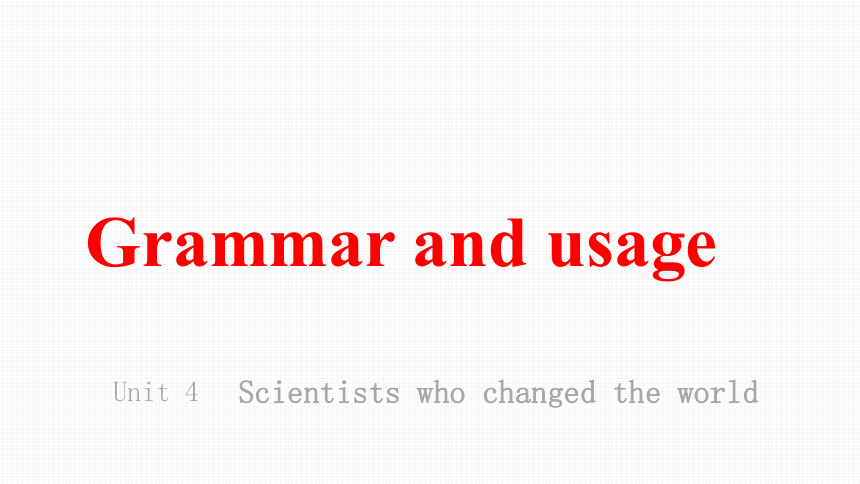 | |
| 格式 | pptx | ||
| 文件大小 | 69.0KB | ||
| 资源类型 | 教案 | ||
| 版本资源 | 牛津译林版(2019) | ||
| 科目 | 英语 | ||
| 更新时间 | 2024-04-02 22:19:44 | ||
图片预览

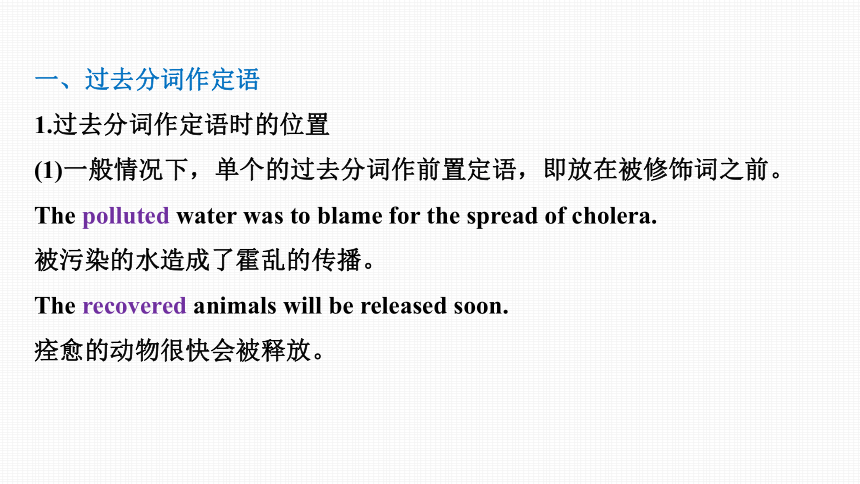
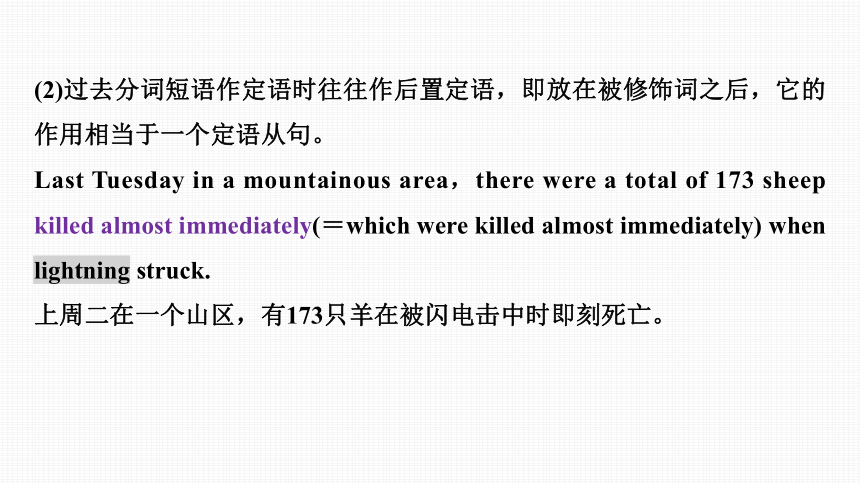
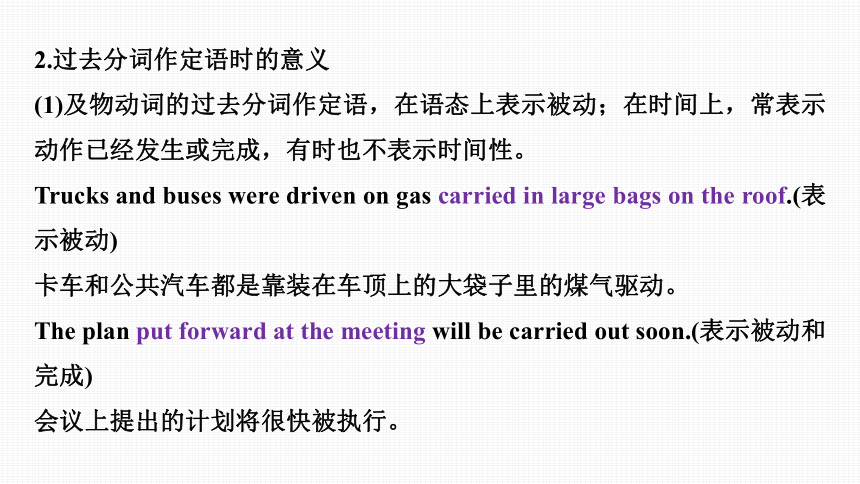
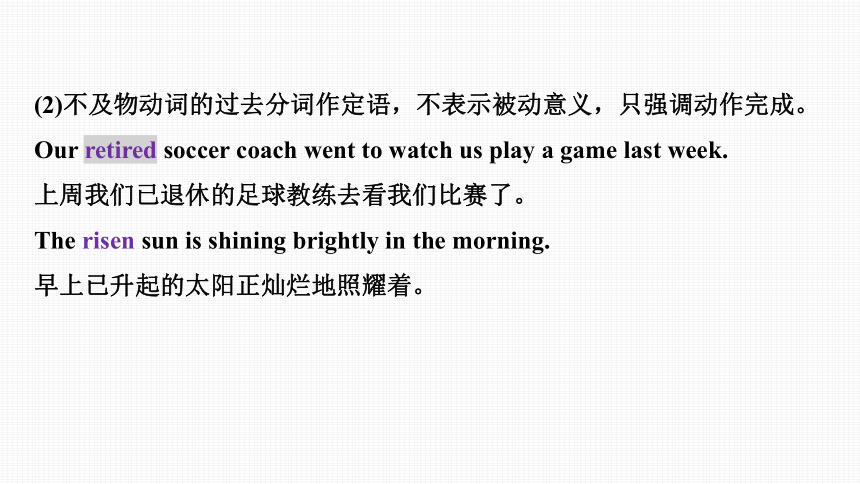

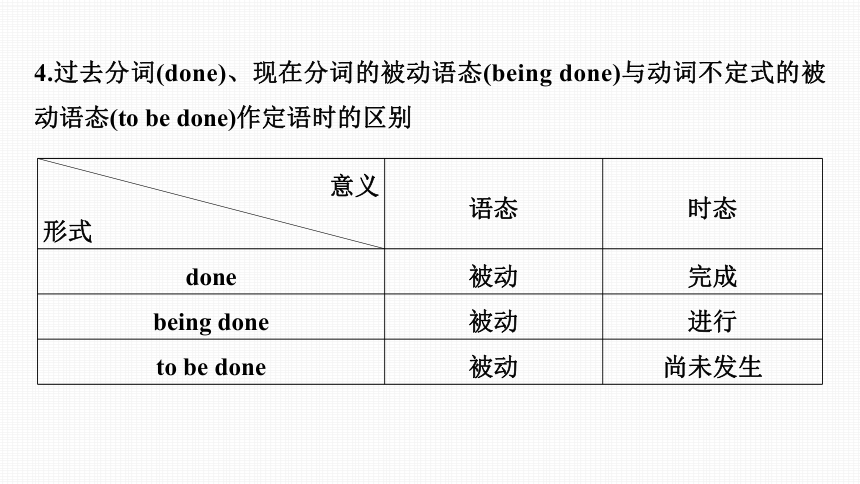
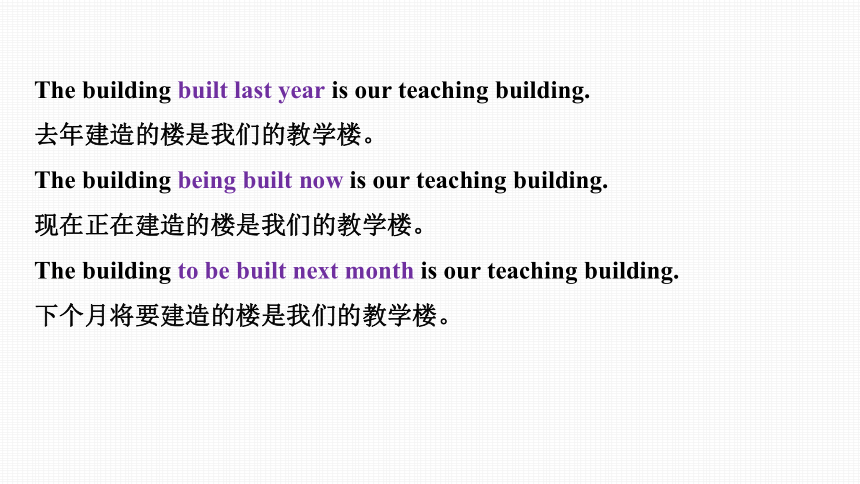
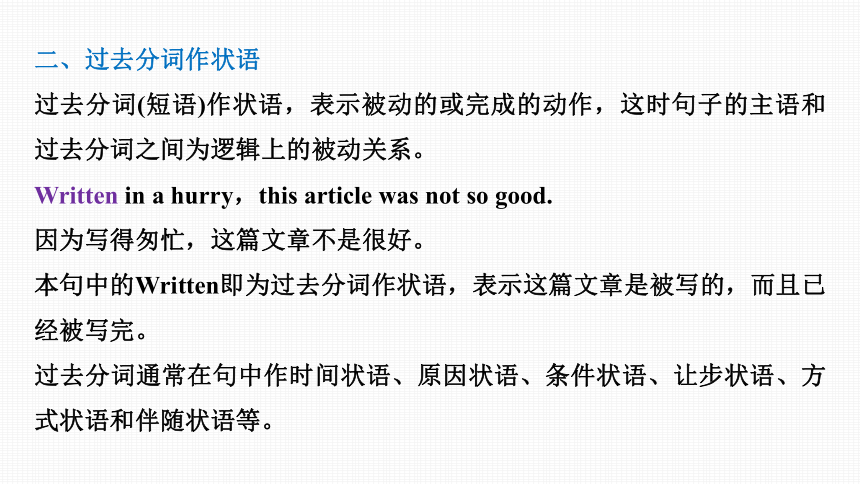
文档简介
(共21张PPT)
Grammar and usage
Unit 4
Scientists who changed the world
一、过去分词作定语
1.过去分词作定语时的位置
(1)一般情况下,单个的过去分词作前置定语,即放在被修饰词之前。
The polluted water was to blame for the spread of cholera.
被污染的水造成了霍乱的传播。
The recovered animals will be released soon.
痊愈的动物很快会被释放。
(2)过去分词短语作定语时往往作后置定语,即放在被修饰词之后,它的作用相当于一个定语从句。
Last Tuesday in a mountainous area,there were a total of 173 sheep killed almost immediately(=which were killed almost immediately) when lightning struck.
上周二在一个山区,有173只羊在被闪电击中时即刻死亡。
2.过去分词作定语时的意义
(1)及物动词的过去分词作定语,在语态上表示被动;在时间上,常表示动作已经发生或完成,有时也不表示时间性。
Trucks and buses were driven on gas carried in large bags on the roof.(表示被动)
卡车和公共汽车都是靠装在车顶上的大袋子里的煤气驱动。
The plan put forward at the meeting will be carried out soon.(表示被动和完成)
会议上提出的计划将很快被执行。
(2)不及物动词的过去分词作定语,不表示被动意义,只强调动作完成。
Our retired soccer coach went to watch us play a game last week.
上周我们已退休的足球教练去看我们比赛了。
The risen sun is shining brightly in the morning.
早上已升起的太阳正灿烂地照耀着。
3.过去分词与现在分词作定语的区别
意义 形式 语态 时态
过去分词 被动 完成
现在分词 主动 进行
As we all know,China is a developing country.
众所周知,中国是一个发展中国家。
The visitor comes from a developed country.
这名游客来自一个发达国家。
4.过去分词(done)、现在分词的被动语态(being done)与动词不定式的被动语态(to be done)作定语时的区别
意义 形式 语态 时态
done 被动 完成
being done 被动 进行
to be done 被动 尚未发生
The building built last year is our teaching building.
去年建造的楼是我们的教学楼。
The building being built now is our teaching building.
现在正在建造的楼是我们的教学楼。
The building to be built next month is our teaching building.
下个月将要建造的楼是我们的教学楼。
二、过去分词作状语
过去分词(短语)作状语,表示被动的或完成的动作,这时句子的主语和过去分词之间为逻辑上的被动关系。
Written in a hurry,this article was not so good.
因为写得匆忙,这篇文章不是很好。
本句中的Written即为过去分词作状语,表示这篇文章是被写的,而且已经被写完。
过去分词通常在句中作时间状语、原因状语、条件状语、让步状语、方式状语和伴随状语等。
1.过去分词作时间状语,在句中相当于一个时间状语从句。
Asked about his address(=When he was asked about his address),the boy didn’t respond.
被问及他的地址时,小男孩没有作答。
2.过去分词作原因状语,在句中相当于一个原因状语从句。
Annoyed at the decision(=As he was annoyed at the decision),he refused to attend the meeting.
由于对这个决定感到恼火,他拒绝参加会议。
3.过去分词作条件状语,在句中相当于一个条件状语从句。
Given more time(=If they were given more time),the trees could grow taller.
如果再多给一点时间,这些树会长得更高。
Heated to a high temperature(=If it is heated to a high temperature),water will change into vapor.
如果加热到高温,水就能变成蒸汽。
4.过去分词作让步状语,在句中相当于一个让步状语从句。
Though warned of the storm(=Though they had been warned of the storm),the farmers were still working in the fields.
尽管被警告过有暴风雨,农民们仍然在田里劳作。
5.过去分词作方式、伴随状语。
Followed by a group of students,the teacher entered the classroom.
=The teacher entered the classroom and he was followed by a group of students.
老师走进教室,后面跟着一群学生。
注意:过去分词(短语)作状语时,前面有时可以加上when,if,while,though,even if,until,unless等连词,这种结构可以看作是一种省略的状语从句(省略部分多为“主语+be的多种形式”)。需要注意的是,省略的主语必须和主句的主语相同或为it。
Even if invited(=Even if I’m invited),I won’t take part in the party.
即使受到邀请,我也不会参加那个聚会的。
6.现在分词作状语与过去分词作状语的区别。
(1)现在分词作状语时,现在分词所表示的动作与句子主语之间构成逻辑上的主动关系。
The girl went out,shutting the door behind her.
女孩出去后将身后的门随手关上。
Not knowing what to do,she went to her parents for help.
由于不知如何是好,她去找她的父母帮忙。
(2)过去分词作状语时,过去分词所表示的动作与句子主语之间构成逻辑上的被动关系。
Given more encouragement,the girl could have behaved better.
如果多给这个女孩一些鼓励,她本来可以表现得更好。
Faced with difficulties,you must try to overcome them.
在遇到困难时,你必须设法去克服它们。
(3)部分过去分词来源于系表结构,作状语时不表示被动关系,而是强调状态。这样的过去分词及短语常见的有:lost in(陷入某种状态)、seated(坐着的)、hidden(躲着)、lost/absorbed(沉溺于)、dressed in(穿着)、tired of(厌烦了)等。
Lost/Absorbed in deep thought,she didn’t hear the sound.
沉浸在深思中,她没有听到那阵声音。
Born in this beautiful town,the girl hates to leave it.
出生于这座美丽的小镇,女孩不愿离开它。
三、过去分词作宾语补足语
1.过去分词用在表状态的keep,leave等词的后面作宾语补足语。
He got up late and hurried to his office,leaving the breakfast untouched.
他起床晚了,没吃早饭就匆忙去上班了。
2.过去分词用在使役动词have/get和make的后面作宾语补足语。
(1)“have/get+宾语+过去分词”可以表示两种含义:“让别人做某事”或“遭遇到某种不幸”。
Claire had her luggage checked an hour before her plane left.
飞机起飞前一个小时克莱儿对她的行李进行了安检。
While they were on holiday,they had their car broken into.
他们在度假时,他们的汽车被撬开了。
(2)在“make+宾语+过去分词”这种结构中,过去分词与宾语之间是被动关系。
They managed to make themselves understood by using very simple English.
他们用很简单的英语来努力使自己被理解。
3.感官动词see,hear,notice,observe,watch,feel,find等后,可用过去分词作宾语补足语。
When we saw the road blocked with snow,we decided to spend the holiday at home.
当我们看到道路被雪封住后,我们决定在家度过假期。
The next morning people found the world outside their houses completely changed.
第二天早上,人们发现他们房子外面的世界完全变了样。
4.表示“意愿;命令”的动词,如like,want,wish,expect,order等可用过去分词作宾语补足语。
The manager ordered the work finished at the end of this week.
经理要求在本周末完成这项工作。
5.过去分词用在“with+宾语+宾语补足语”这一结构中,过去分词与宾语之间是动宾关系。
The living room is clean and tidy,with a dining table already laid for a meal to be cooked.
客厅既干净又整洁,已经为即将做好的饭菜摆好了餐桌。
John received an invitation to dinner,and with his work finished,he gladly accepted it.
约翰收到一份宴请函,而且他的工作也做完了,他就欣然接受了邀请。
Grammar and usage
Unit 4
Scientists who changed the world
一、过去分词作定语
1.过去分词作定语时的位置
(1)一般情况下,单个的过去分词作前置定语,即放在被修饰词之前。
The polluted water was to blame for the spread of cholera.
被污染的水造成了霍乱的传播。
The recovered animals will be released soon.
痊愈的动物很快会被释放。
(2)过去分词短语作定语时往往作后置定语,即放在被修饰词之后,它的作用相当于一个定语从句。
Last Tuesday in a mountainous area,there were a total of 173 sheep killed almost immediately(=which were killed almost immediately) when lightning struck.
上周二在一个山区,有173只羊在被闪电击中时即刻死亡。
2.过去分词作定语时的意义
(1)及物动词的过去分词作定语,在语态上表示被动;在时间上,常表示动作已经发生或完成,有时也不表示时间性。
Trucks and buses were driven on gas carried in large bags on the roof.(表示被动)
卡车和公共汽车都是靠装在车顶上的大袋子里的煤气驱动。
The plan put forward at the meeting will be carried out soon.(表示被动和完成)
会议上提出的计划将很快被执行。
(2)不及物动词的过去分词作定语,不表示被动意义,只强调动作完成。
Our retired soccer coach went to watch us play a game last week.
上周我们已退休的足球教练去看我们比赛了。
The risen sun is shining brightly in the morning.
早上已升起的太阳正灿烂地照耀着。
3.过去分词与现在分词作定语的区别
意义 形式 语态 时态
过去分词 被动 完成
现在分词 主动 进行
As we all know,China is a developing country.
众所周知,中国是一个发展中国家。
The visitor comes from a developed country.
这名游客来自一个发达国家。
4.过去分词(done)、现在分词的被动语态(being done)与动词不定式的被动语态(to be done)作定语时的区别
意义 形式 语态 时态
done 被动 完成
being done 被动 进行
to be done 被动 尚未发生
The building built last year is our teaching building.
去年建造的楼是我们的教学楼。
The building being built now is our teaching building.
现在正在建造的楼是我们的教学楼。
The building to be built next month is our teaching building.
下个月将要建造的楼是我们的教学楼。
二、过去分词作状语
过去分词(短语)作状语,表示被动的或完成的动作,这时句子的主语和过去分词之间为逻辑上的被动关系。
Written in a hurry,this article was not so good.
因为写得匆忙,这篇文章不是很好。
本句中的Written即为过去分词作状语,表示这篇文章是被写的,而且已经被写完。
过去分词通常在句中作时间状语、原因状语、条件状语、让步状语、方式状语和伴随状语等。
1.过去分词作时间状语,在句中相当于一个时间状语从句。
Asked about his address(=When he was asked about his address),the boy didn’t respond.
被问及他的地址时,小男孩没有作答。
2.过去分词作原因状语,在句中相当于一个原因状语从句。
Annoyed at the decision(=As he was annoyed at the decision),he refused to attend the meeting.
由于对这个决定感到恼火,他拒绝参加会议。
3.过去分词作条件状语,在句中相当于一个条件状语从句。
Given more time(=If they were given more time),the trees could grow taller.
如果再多给一点时间,这些树会长得更高。
Heated to a high temperature(=If it is heated to a high temperature),water will change into vapor.
如果加热到高温,水就能变成蒸汽。
4.过去分词作让步状语,在句中相当于一个让步状语从句。
Though warned of the storm(=Though they had been warned of the storm),the farmers were still working in the fields.
尽管被警告过有暴风雨,农民们仍然在田里劳作。
5.过去分词作方式、伴随状语。
Followed by a group of students,the teacher entered the classroom.
=The teacher entered the classroom and he was followed by a group of students.
老师走进教室,后面跟着一群学生。
注意:过去分词(短语)作状语时,前面有时可以加上when,if,while,though,even if,until,unless等连词,这种结构可以看作是一种省略的状语从句(省略部分多为“主语+be的多种形式”)。需要注意的是,省略的主语必须和主句的主语相同或为it。
Even if invited(=Even if I’m invited),I won’t take part in the party.
即使受到邀请,我也不会参加那个聚会的。
6.现在分词作状语与过去分词作状语的区别。
(1)现在分词作状语时,现在分词所表示的动作与句子主语之间构成逻辑上的主动关系。
The girl went out,shutting the door behind her.
女孩出去后将身后的门随手关上。
Not knowing what to do,she went to her parents for help.
由于不知如何是好,她去找她的父母帮忙。
(2)过去分词作状语时,过去分词所表示的动作与句子主语之间构成逻辑上的被动关系。
Given more encouragement,the girl could have behaved better.
如果多给这个女孩一些鼓励,她本来可以表现得更好。
Faced with difficulties,you must try to overcome them.
在遇到困难时,你必须设法去克服它们。
(3)部分过去分词来源于系表结构,作状语时不表示被动关系,而是强调状态。这样的过去分词及短语常见的有:lost in(陷入某种状态)、seated(坐着的)、hidden(躲着)、lost/absorbed(沉溺于)、dressed in(穿着)、tired of(厌烦了)等。
Lost/Absorbed in deep thought,she didn’t hear the sound.
沉浸在深思中,她没有听到那阵声音。
Born in this beautiful town,the girl hates to leave it.
出生于这座美丽的小镇,女孩不愿离开它。
三、过去分词作宾语补足语
1.过去分词用在表状态的keep,leave等词的后面作宾语补足语。
He got up late and hurried to his office,leaving the breakfast untouched.
他起床晚了,没吃早饭就匆忙去上班了。
2.过去分词用在使役动词have/get和make的后面作宾语补足语。
(1)“have/get+宾语+过去分词”可以表示两种含义:“让别人做某事”或“遭遇到某种不幸”。
Claire had her luggage checked an hour before her plane left.
飞机起飞前一个小时克莱儿对她的行李进行了安检。
While they were on holiday,they had their car broken into.
他们在度假时,他们的汽车被撬开了。
(2)在“make+宾语+过去分词”这种结构中,过去分词与宾语之间是被动关系。
They managed to make themselves understood by using very simple English.
他们用很简单的英语来努力使自己被理解。
3.感官动词see,hear,notice,observe,watch,feel,find等后,可用过去分词作宾语补足语。
When we saw the road blocked with snow,we decided to spend the holiday at home.
当我们看到道路被雪封住后,我们决定在家度过假期。
The next morning people found the world outside their houses completely changed.
第二天早上,人们发现他们房子外面的世界完全变了样。
4.表示“意愿;命令”的动词,如like,want,wish,expect,order等可用过去分词作宾语补足语。
The manager ordered the work finished at the end of this week.
经理要求在本周末完成这项工作。
5.过去分词用在“with+宾语+宾语补足语”这一结构中,过去分词与宾语之间是动宾关系。
The living room is clean and tidy,with a dining table already laid for a meal to be cooked.
客厅既干净又整洁,已经为即将做好的饭菜摆好了餐桌。
John received an invitation to dinner,and with his work finished,he gladly accepted it.
约翰收到一份宴请函,而且他的工作也做完了,他就欣然接受了邀请。
同课章节目录
- Unit 1 Nature in the balance
- Welcome to the unit
- Reading
- Grammar and usage
- Integrated skills
- Extended reading
- Project
- Unit 2 Natural disasters
- Welcome to the unit
- Reading
- Grammar and usage
- Integrated skills
- Extended reading
- Project
- Unit 3 The world online
- Welcome to the unit
- Reading
- Grammar and usage
- Integrated skills
- Extended reading
- Project
- Unit 4 Scientists who changed the world
- Welcome to the unit
- Reading
- Grammar and usage
- Integrated skills
- Extended reading
- Project
